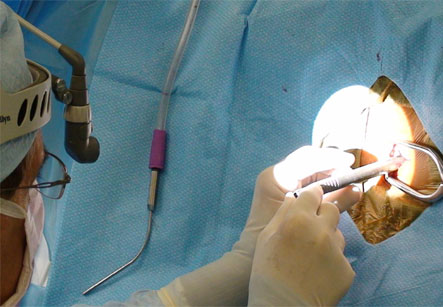Keyhole Surgery
Introduction
Keyhole spine surgery is the name given to an endoscopic procedure that uses advanced video cameras and instruments which can be passed through small incisions (less than 2 cm) in the back, chest or abdomen to access the spine to perform the needed surgery.
The endoscopic techniques used in other surgical disciplines have now expanded their scope to the treatment of spine disorders. This surgery can be performed for spinal tumors, deformities, injuries and degenerative diseases.
However, not every patient can be a candidate for a minimally invasive approach of spine surgery. To see if the patient is a suitable candidate for this approach, full evaluation is necessary by a surgeon experienced in such minimally invasive techniques.
Indications or conditions treated:
The keyhole or minimally invasive surgeries are useful in certain cases of degenerative discs, scoliosis, kyphosis, spinal column tumors, infection, fractures and herniated discs. This surgery may speed recovery, minimize post-operative pain and improve the final outcome. Many types of spine surgeries can be performed by this technique and they include:
1. Spinal fusion, which is often performed for degeneration of disks
2. Deformity corrections for kyphosis or scoliosis
3. Repair or replacement of herniated disks
We have all the information you need about public and private clinics and hospitals that provide spinal surgery in Iran, Islamic Republic Of with the best quality and lowest possible prices

4. Decompression of spinal tumors
5. Repair and stabilization of vertebral compression fractures
6. Micro-endoscopic discectomy
7. Cervical foraminotomy
Benefits of keyhole spine surgery:
The keyhole spine surgery offers several advantages as compared with open surgery. The conventional surgery typically requires large incisions, muscle stripping, more anesthetic medications, prolonged hospital stay, and a long recovery period. The benefits of spine surgery include:
1. A few tiny scars instead of one large scar
2. Shorter hospital stay
3. Reduced pain in the postoperative period
4. Shorter recovery time, a few months instead of a year
5. Swift return to daily activities, including work
6. Less blood loss
7. Reduced risk of infection
8. Reduced soft tissue and muscle damage
Preparation:
1. Quit smoking in case if you smoke
2. Exercise on a regular basis to improve the recovery rate
3. Stop taking any blood thinning medications
4. Continuing ongoing treatment for diseases such as heart disease or hypertension
Procedure:
Most types of keyhole surgery are performed with the help of a thin telescope-like instrument, called as endoscope. The surgery is done under the guidance of a portable X-ray machine, called as fluoroscope. The fluoroscope is positioned around the patient in such a way as to give the surgeon the best X-ray view from which he can see the anatomy of the spine. The endoscope is inserted through one of the multiple small incisions or ports made in the body. The endoscope is attached to a tiny video camera which projects an internal view of the patient’s body on a television screen in the operating room. Small surgical instruments are inserted through one or more half-inch incisions and appropriate surgical procedure is performed. After completion of surgery, the incisions are closed with sutures and covered with surgical bandages.
Risks of keyhole spine surgery:
As with any surgical procedure, this type of surgery also involves general risks and procedure-specific risks. The common general risks of spine surgery include:
1. Adverse reactions to the anesthetic medications
2. Breathing problems
3. Post-operative pneumonia
4. Blood clots in the legs (deep vein thrombosis) that may travel to the lungs (pulmonary embolism)
5. Infection at the surgical site
6. Blood loss during surgery requiring a transfusion.
The specific risks of spine surgery include:
1. Injury to the nerves or spinal cord
2. Paralysis (the estimated risk of paralysis is about 1 in 10,000)
3. If instrumentation was used, it can break, dislodge or irritate the surrounding tissues
4. Rarely, failure of planned surgery
5. Requirement of conversion to open surgery
6. Rarely leakage of spinal fluid or stroke
Outcome
The keyhole spine surgery offers several advantages as compared with open surgery.
As keyhole spinal surgery is a fairly new procedure, there is very little long-term outcome data available. In general, there is very little blood loss with this procedure. Many patients can move about within a few hours and discharged from the hospital the next day of surgery. Patients are often back to their work within a few weeks.